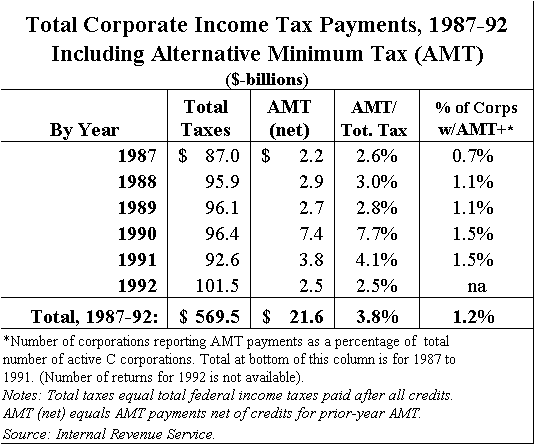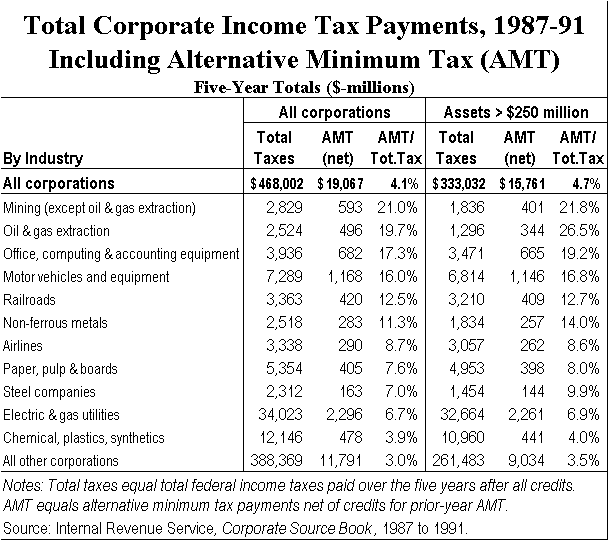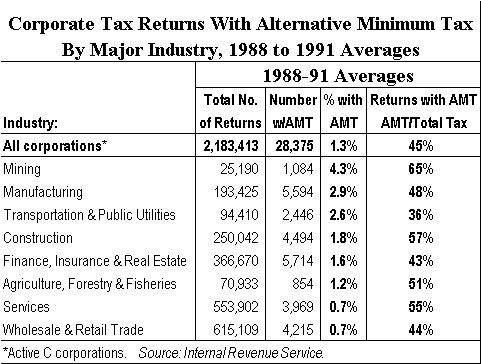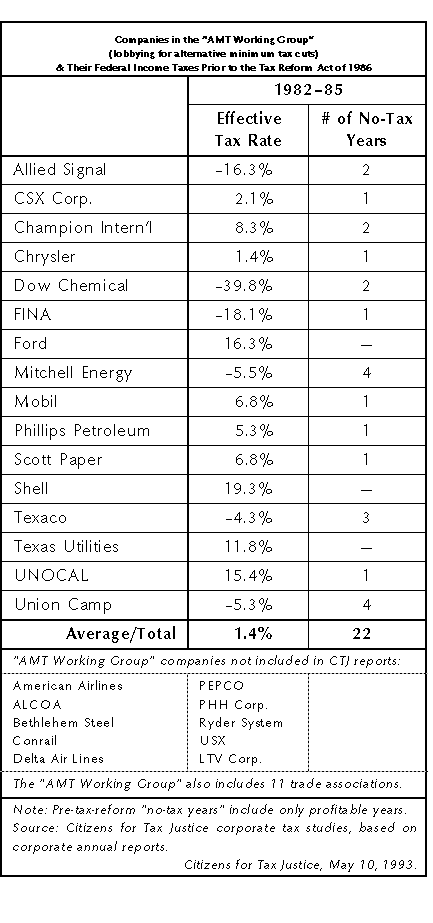May 17, 1995 02:20 PM | Permalink | ![]()
Statement of Robert S. McIntyre
Director, Citizens for Tax Justice
Concerning Proposals for a Flat-Rate Consumption Tax
Before the Joint Economic Committee
May 17, 1995
I appreciate the opportunity to testify before the Committee on behalf of Citizens for Tax Justice. Our coalition of labor, public interest and grassroots citizens groups represents tens of millions of middle- and low-income Americans, who have a vital stake in fair, economically sound tax and budget policies.
According to Chairman Mack, “The purpose of this hearing is to explore how the implementation of a flat tax would impact economic growth in the United States.” In other words, the question before the Committee today is the following:
How would very large tax increases on middle- and low-income families, coupled with huge tax cuts for the very rich, affect the economy?
We believe the answer to this question is quite clear. Higher taxes on average American families to pay for tax cuts for the wealthy is a terrible idea, both unfair and bad economics. That so-called “supply-side” policy was tried in the Carter and early Reagan years, and failed so miserably that President Reagan himself rejected it. We should not repeat those mistakes again.
1. The Great Middle-Class Tax Hike
There is little or no disagreement among serious analysts that replacing the current, progressive income tax with a flat-rate tax would dramatically shift the tax burden away from the wealthy–and onto the middle class and the poor.
(LATEST DISTRIBUTIONAL TABLES AVAILABLE @ctj.org)
Indeed, it seems hard to deny this obvious fact. Right now, our personal income tax starts with a zero effective rate (or less) on lower-income families (up to about $23,200 for a family of four) and goes up to a 39.6 percent top marginal rate on the incomes of the best-off one percent. Replace that with a flat-rate tax of, say, 20 percent and clearly the rich will pay far, far less in taxes. This effect would be compounded by the fact that the leading flat-rate plans (from Rep. Armey and Sen. Specter) are based on a plan put forward by Robert Hall and Alvin Rabushka that is designed to tax only consumption rather than income. (1) (This result would be achieved by allowing immediate deductions for tangible business investments and by exempting interest, dividends and capital gains from individual taxation.) Thus, not only would the flat tax rate on the wealthy be much lower, but a large share of the wealthy’s income wouldn’t be taxed at all. That inexorably would leave middle- and low-income families holding the bag.
At a 1982 Senate Finance Committee hearing on various tax proposals (including an Armey-style plan), the Reagan Treasury Department testified that “any” flat-rate tax “would involve a significant redistribution of tax liability” away from the wealthy and onto average taxpayers. More recently, the Treasury Department has undertaken a detailed analysis of Rep. Armey’s specific flat-tax plan.(2) Once Rep. Armey’s proposed exemptions are adjusted downward to avoid the huge revenue losses the plan would otherwise entail, Treasury’s analysis shows that the typical family would pay close to $2,000 a year in additional taxes under the Armey flat tax. Very rich people, however, would get tax cuts averaging more than $50,000 each. (3) Treasury’s findings have been confirmed by the authors of the original Armey and Specter-style flat tax. In their 1983 book, Low Tax, Simple Tax, Flat Tax, Hall and Rabushka noted that their flat tax “will be a tremendous boon to the economic elite.(4) They honestly delivered what they admitted was “some bad news”: “it is an obvious mathematical law that lower taxes on the successful will have to be made up by higher taxes on average people.”(5) In fact, much like Treasury, Hall and Rabushka calculated that their flat tax would raise taxes by $1,400 to $2,400 year (in today’s dollars) on families earning between $25,000 and $75,000. But “the truly successful get a better and better deal,” they point out. “Families with incomes around [$285,000] receive tax breaks of about 7 percent of income, those with incomes of [$1.5 million] get 10 percent, and the handful with incomes approaching [$4 million] get 13 percent.”(6)
To be sure, some flat-tax advocates have been less than fully candid about the effects of their plans. Representative Armey, for example, tries to sell his flat tax by (a) denying that his proposed 17% rate and high exemptions entail a huge revenue shortfall, (b) nevertheless insisting that almost everyone will get a tax cut, and (c) talking only about the wage portion of his tax, while pretending that nobody pays the business sales tax part (even though it would apply to everything from groceries to health care to new homes) or his tax on fringe benefits.
To supplement Treasury’s analysis, we have prepared some detailed examples of how the Armey flat tax would affect typical families, focusing for simplicity on non-elderly couples with two children, and based on actual tax-return and Census data (aged to 1996 levels). Our results are similar to those shown in the tables presented by the Treasury and by Hall and Rabushka in 1983. For example:
- Family income: $25,000. Under current law, a family of four earning $25,000 pays essentially nothing in combined personal and corporate income taxes. (What taxes would otherwise be due are offset by the earned-income tax credit, which would be repealed under the Armey plan, and apparently by Sen. Specter’s plan as well.) Under the Armey plan, with its proposed exemptions but with a 22.6% break-even tax rate, such a family would typically pay $810 in taxes on its $3,600 in fringe benefits and $1,540 as its share of the business tax. Thus, its tax bill under the Armey flat tax would increase by about $2,400. Under the alternative scenario, with a 17% tax rate, but lower exemptions, this family’s tax bill would increase by almost $3,700.
- Family income: $45,000. Under current law, this family’s tax bill would typically be about $3,800. Under the Armey plan, its taxes would increase by $1,740 to $4,200 a year, depending on the version.
- Family income: $85,000. Current law personal and corporate income taxes on this family would typically amount to $11,140. Under the Armey plan, wage taxes alone would be $10,400 to $11,650. When taxes on fringe benefits and the business tax are added in, this family would owe $4,600 or more a year in additional taxes.
- Family income: $500,000. Under current law, this family would pay $154,000 in combined personal and corporate income taxes. Under the Armey plan, the family’s tax would be slashed by half or more–for a tax cut of between $78,000 and $93,000 annually.
(LATEST TABLE OF EXAMPLES AVAILABLE @ctj.org)
2. How Would Raising Taxes on the Middle-Class and the Poor –to Pay for Tax Cuts for the Rich–Affect the Economy?
The notion that shifting the tax burden away from the rich and onto the middle-class and poor will help the economy is not a new idea. Often referred to (even by proponents) as “trickle-down” economics,(7) this approach had its most recent major test in the so-called “supply-side” tax bills of 1978 and 1981. In the Carter administration, the 1978 Revenue Act sharply reduced taxes on capital gains and expanded corporate tax breaks. Then Ronald Reagan’s 1981 tax act slashed taxes on corporate profits and personal investment income. Meanwhile, as taxes plummeted on the affluent, inflation and rising payroll taxes led to higher and higher effective tax rates on nine out of ten American families.
“Supply-side” proponents of the tax-shift policies adopted during the Carter and early Reagan years confidently predicted that their approach would produce an investment-led economic boom. But despite the rosy scenarios, the supply-side experiment failed. After the 1978 capital gains tax cut was enacted, for example, the GDP dropped by 1% over the next year and a half.(8) Likewise, adoption of the 1981 supply-side tax-loophole bill was followed by the deepest recession since the 1930s.
After several years of weak business investment, rampant tax-sheltering and huge budget deficits, President Reagan himself switched gears. The supply-siders were banished and Reagan helped lead the charge for the loophole-closing 1986 Tax Reform Act. The result was a fairer, more efficient tax code that treats income more equally, regardless of how it’s earned or used. And to the consternation of the supply-siders, productive investment surged dramatically after the loopholes were closed and business tax avoidance was curtailed.
| Annual Rates of Change In Business Investment in the 1980s (Real Private Non-Residential Fixed Investment) | ||
| 1981-86 | 1986-89 | |
| All Business Investment | +1.9% | +2.7% |
| Structures | -0.7% | +0.2% |
| Industrial buildings | -6.8% | +8.0% |
| Commercial buildings | +6.8% | -1.3% |
| All other structures | -3.4% | -1.4% |
| Equipment | +3.5% | +4.1% |
| Industrial equipment | +0.1% | +4.0% |
| Computers & office equip. | +22.6% | +8.8% |
| All other equipment | +2.8% | +3.2% |
| Addendum: Ind. equip. & build. | -2.0% | +5.1% |
| Source: U.S. Dept. of Commerce, Bureau of Economic Analysis, Mar. 1992 | ||
Real business investment grew by 2.7% a year from 1986 to 1989. That was 43 percent faster than the paltry 1.9% growth rate from 1981 to 1986. Even more significant, while construction of unneeded office buildings tapered off after tax reform, business investment in industrial machinery and plants boomed. As money flowed out of wasteful tax shelters, industrial investment jumped by 5.1% a year from 1986 to 1989, after actually falling at a 2% annual rate from 1981 to 1986. As former Reagan Treasury official, J. Gregory Ballentine, told Business Week: “It’s very difficult to find much relationship between [corporate tax breaks] and investment. In 1981 manufacturing had its largest tax cut ever and immediately went down the tubes. In 1986 they had their largest tax increase and went gangbusters [on investment].”
More recently, our economy has enjoyed an investment-led economic rejuvenation following the increases in the top tax rates on corporations and the best-off people in President Clinton’s 1993 deficit reduction act. Indeed, from the third quarter of 1993 (when the deficit reduction act was approved) through the end of 1994, real GDP rose by 5.7%, led by real business investment growth of 18.4%. The stock market is at a record high. Indeed, the economy has done so well since 1993 that the Federal Reserve has taken repeated steps to try to slow it down.
One might have thought–or at least hoped–that the soak-the-poor-and-the-middle-class tax-shift theories of the discredited supply-siders would have been laid to rest by the events of the past two decades. But sadly, that does not appear to be the case. The expensive new corporate and high-income loopholes included in the House-passed “Contract with America” tax bill are essentially an attempt to repeat the failed loophole-based tax policies of the Carter and early Reagan years. (The bill even includes a “Trojan Horse” of children’s tax credits to divert attention from the sharp reductions in capital gains and corporate taxes that are the true centerpiece of the plan.)
The Hall-Rabushka flat-rate consumption tax and its variants are an attempt to go much further. Among other things, the corporate income tax would be entirely repealed–replaced with what amounts to a modified value-added tax. Interest would be taken entirely out of the tax base. Dividends would no longer be taxed, nor would most capital gains. In short, the flat-tax proponents want to consolidate the current special tax breaks for income from capital into one giant, all-encompassing loophole. Then, on top of that, graduated tax rates would be abandoned in favor of a single flat tax rate.
The unreconstructed supply-siders who promote these regressive tax changes offer fanciful predictions about how their plan to shift the tax burden away from the rich and onto the middle class and the poor would supposedly boost economic growth. But they have been consistently wrong in the past, and they are wrong once again. Indeed, the flat-tax plan is so poorly worked out, that it would produce a major, negative upheaval in the economy that could take years to overcome.
3. Conclusion
Proposals for a flat-rate consumption tax would move our tax system in exactly the wrong direction, for both our economy and for tax fairness. Rather than expanding tax entitlements for corporations and the well off and lowering their tax rates, we should seek real tax reform. In our view that means that existing loopholes should be curtailed, tax laws simplified, and graduated tax rates maintained.(9)
Appendix: The structure of the Armey-Specter-Hall-Rabushka flat tax.
The Hall-Rabushka flat tax, and its Armey and Specter variants, would replace the current personal and corporate income taxes with a new tax that is conceptually identical to a “subtraction-method” value-added tax, a version of a national sales tax, with two major modifications: First, imports would be exempt from the flat tax, while exports would be subject to tax. Second, to mitigate the regressivity of the VAT, cash wages, pensions received and other cash earned income would be taken out of the VAT base (i.e., deducted by businesses) and taxed directly to individuals, with exemptions. Thus, structurally, the flat tax is exactly equal to a value-added tax with an import incentive, an export disincentive and a personal rebate based on a percentage of a capped amount of cash wages, pensions and other earned income.(10)
The “business” tax: Although the corporate income tax would be repealed, its structure and most of its complexity would be retained in order to collect the modified value-added tax that is the centerpiece of the flat tax plan.
The flat-tax’s business tax form, which would be filed by corporations, self-employed people, partnerships, unincorporated companies, investors in rental properties, and anyone else engaged in business activities, would retain most of the trappings of the current corporate income tax (including the numerous, necessary rules defining gross receipts and allowable deductions) with the following modifications:(11)
- Capital investments in tangible property (such as machinery, buildings, land, inventories, etc.) would be expensed, rather than depreciated or amortized over time. This is consistent with the stated goal of taxing only personal consumption, and is intended to produce a zero tax rate on profits from new capital investments.
- Non-cash wages (i.e., non-pension fringe benefits such as employee health insurance) would not be deductible, and thus (unlike current income tax law) would be taxed. This is consistent with the treatment of wages generally under a normal value-added tax, but can also be seen as a withholding tax on employee fringe benefits.
- Interest income would be exempt from tax, and business interest expenses would not be deductible.
- Banks and other financial institutions would include in gross receipts the value of services provided to customers “for free” (i.e., “free” checking accounts, loan services accounted for by higher interests rates, etc.).
- Business entertainment outlays would be fully deductible (rather than only 50% deductible as under current law).
- Businesses with an excess of deductions over receipts would carry over the excess, on which the government would pay interest when the amounts are eventually deducted.(12)
After a long and troublesome transition,(13) the long-term impact of the flat tax’s business tax is supposed to approximate a consumption tax (except for its odd treatment of imports and exports). As Hall and Rabushka note in the revised version of their book, “The business tax is not a profit tax.” (14)Instead, “The flat tax, by expensing investment, is precisely a consumption tax.”(15)
Although flat-tax backers seem to think that their business sales tax would be immune from political pressures, this is not the experience with value-added taxes in Europe, nor with sales taxes in the states. On the contrary, lobbying for special exemptions and loopholes is rampant with those taxes, cheating is widespread and administrative costs are generally as high or higher than for income taxes.(16)
Personal taxes: Individuals would pay taxes directly only on wages, pensions, unemployment compensation and certain other income characterized as “earned.” Individual business owners, partners, etc. could report their earned income on the “wage tax” form by paying themselves a salary (thereby taking advantage of the wage-tax exemptions), but they would have to file the business tax form as well.
Besides smaller type, consolidation of several lines into cryptic, hard-to-audit summaries and elimination of some anti-fraud provisions, the major changes that the wage-tax form entails from the current income tax form include:(17)
- Personal Income:
- There would be a 100% exclusion for interest income.
- There would be a 100% exclusion for dividends.
- There would be a 100% exclusion for capital gains from selling stocks and other intangible assets.
- Business receipts, rents, royalties, partnership receipts, farm receipts and so forth would not be reported on the personal tax form, but instead on the separate business tax form.
- Personal Adjustments, Deductions and Credits:
- None of the current adjustments, for self-employed pension contributions, IRAs, self-employed health insurance, FICA taxes, or alimony paid, would be allowed.
- Itemized deductions, for state and local income and property taxes, mortgage interest, charitable donations, extraordinary medical expenses, job-related expenses and so forth would be eliminated. Sen. Specter’s plan, however, would allow charitable deductions of up to $2,500 a year and mortgage interest on up to $100,000 in debt for all tax filers with such outlays, thereby greatly increasing the number of taxpayers itemizing deductions.
- The child-care credit, earned-income tax credit for the working poor, credit for excess social security taxes withheld, and all other tax credits would be repealed.
1. Hall and Rabushka used to be very reluctant to admit that their plan was a consumption tax. At a Senate Finance Committee hearing back in 1982, Sen. Bill Bradley asked Hall: “So you are advocating a consumption tax?” To which Hall responded: “That’s right, but we are careful not to label it as a consumption tax.”
In their recent book, The Flat Tax (1995), Hall and Rabushka are less reluctant than confusing. They variously tout their plan, often in juxtaposed paragraphs, as (a) an “airtight tax on . . . income” that “achieve[s] the goal of taxing all income exactly once” and (b) “a tax on consumption” only. The Flat Tax, pp. 72-73. Obviously, however, their plan cannot be both an income tax and a consumption tax.
4. “Robert Hall and Alvin Rabushka, Low Tax, Simple Tax, Flat Tax (1983), p. 67.
14. Robert E. Hall and Alvin Rabushka, The Flat Tax (1995), p. 64.




 That’s not to say, however, that the Alternative Minimum Tax is paid by very many corporations. According to the IRS, from 1987 through 1991 the corporate AMT was paid by about 28,000 corporations a year–only 1.2 percent of all active corporate filers. By major industry, the percentage of corporations paying the AMT (in 1988-91) ranged from 4.3 percent in mining down to 0.7 percent in wholesale and retail trade.
That’s not to say, however, that the Alternative Minimum Tax is paid by very many corporations. According to the IRS, from 1987 through 1991 the corporate AMT was paid by about 28,000 corporations a year–only 1.2 percent of all active corporate filers. By major industry, the percentage of corporations paying the AMT (in 1988-91) ranged from 4.3 percent in mining down to 0.7 percent in wholesale and retail trade.

 Some companies complain that the AMT can be tough on them in bad years. For example, suppose a company “normally” makes $500 million in pretax profits, and that after various special tax write-offs, its taxable income is $250 million. Such a company would “normally” pay 35 percent of that, or $88 million, in regular taxes–a 17.5% effective tax rate that would be unlikely to trigger the alternative minimum tax. But should the company’s pretax profit temporarily fall to, say, only $250 million (due to an short-term downturn in sales), while its special tax write-offs remained constant, then its taxable income would go to zero, and the AMT would probably be triggered.
Some companies complain that the AMT can be tough on them in bad years. For example, suppose a company “normally” makes $500 million in pretax profits, and that after various special tax write-offs, its taxable income is $250 million. Such a company would “normally” pay 35 percent of that, or $88 million, in regular taxes–a 17.5% effective tax rate that would be unlikely to trigger the alternative minimum tax. But should the company’s pretax profit temporarily fall to, say, only $250 million (due to an short-term downturn in sales), while its special tax write-offs remained constant, then its taxable income would go to zero, and the AMT would probably be triggered. More recent corporate annual reports from some of the “AMT Working Group” members show the effects of the current Alternative Minimum Tax. Many of them would pay nothing at all in federal income taxes without the corporate minimum tax. For example:
More recent corporate annual reports from some of the “AMT Working Group” members show the effects of the current Alternative Minimum Tax. Many of them would pay nothing at all in federal income taxes without the corporate minimum tax. For example: